
Lots of fine art afficionados live in wet climates. As such, there are certain requirements which they need to meet in order to preserve their fine art for as long as possible. It doesn’t matter what that fine art looks like, there are steps to take. Here, I’m going to focus on wall art. So, are you ready to learn how to care for your fine art in a wet climate?

There are several kinds of wall art which fall under the heading of fine art. These include art on canvas, art on paper, photographs, and more. Most of the time, these pieces of art are also framed. This adds an extra layer of complexity, as does the frame holding the canvas stretched. We’ll discuss these points as well.
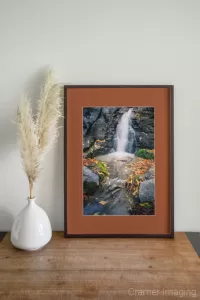
There are good reasons. As the temperature changes, so does the amount of moisture it holds. With changes in temperature and humidity, your fine art will experience some level of stress. The more rapid the fluctuations, the worse the stress it experiences.
Most organic materials used to make your wall art are hygroscopic. This means they will absorb or release moisture corresponding to changes in the surrounding environment. This absorption and release also places the art under stress.
Conditions such as these will contribute to the acceleration of your fine art’s decay. Now let’s look at specific dangers to watch out for.
There are several dangers which any piece of wall art may face in a wet climate. Some are as follows.
As you can see, the list of dangers wet climates pose to fine art is considerable. Let’s dive in a bit deeper so you can understand exactly what dangers these pose.
 Mold comes from fungus growing on soft wet surfaces. Sometimes, you might even find it growing in unexpected places. It happens.
Mold comes from fungus growing on soft wet surfaces. Sometimes, you might even find it growing in unexpected places. It happens.
Mold will disfigure and often permanently stain a piece of wall art. It will literally digest the paper, canvas, and even the paint or emulsion. Once gone, there’s no replacing the damaged areas.
Foxing is often associated with surface mold. It’s also attached to metallic impurities in the backing or other support papers or boards. This is also often irreversible.
There are several types of insect or, perhaps, insectoid which will damage wall art. These include silverfish, borers, flies, carpet beetles, clothes moths, worms, booklice, termites, roaches, and more. These bugs are often region-specific, but humans can accidentally introduce these pests into previously unaffected areas. For example, the emerald ash borer is normally native to Asia. However, it arrived in the US in 2002, likely hidden in wooden packing materials. So far (at time of writing), it’s confined to a handful of states. It will likely spread.

Silverfish, carpet beetles, clothes moths, worms, booklice, termites, borers, roaches, and the like will eat either the art itself or the frame/framing surrounding it. Moths like glues. These pests like more dark and humid environments. Flies will leave small dark deposits on your art. These will eat into paint and varnish layers and permanently disfigure the image.

As far as other pests, mice and rats don’t often eat fine art nor its materials. However, they will seek out burrows and nests wherever they can find them. They will also chew through what they need to in order to create access doorways. With how fast rodent teeth grow, they can chew through practically anything. We certainly don’t want them chewing through your prized fine art. Also, they will urinate and defecate inside the walls. This can and just might leech into your wall art as time passes. However, due to their size, smell, and tendency to chew, you will likely learn about a rodent problem long before it will threaten your art.
The world around us is full of chemicals. Some benign and some less so. Much of the world we know is in some form of chemical reaction. Also, much of what we use to create art comes from chemical reactions. We hope that these reactions are slower than others, but they still progress. In the case of printer ink, paint, photographic emulsions, and more, we want those reactions to progress as slowly as possible This way we can enjoy the unaltered art for as long as possible.

The additions of heat and moisture are well-known catalysts for speeding up certain chemical reactions. Sadly, not all chemical reactions are colorless. Some result in a permanent color change or loss. In more extreme cases, the chemical reaction will damage or even destroy the surrounding materials. In wet climates, we must be more conscious of this problem as wet climates introduce both heat and moisture to the fine art in question.
With the expansion and contraction of materials thanks to heat and humidity, the art will undergo internal stress. Oil paintings, images on canvas, photographs, images on wood, and the like will suffer the most from this problem. As the art, or its framing, expands and contracts, the paint or ink (or other medium) will expand and contract with it. The medium is not designed to stretch nor to contract. It’s meant to stay solid.
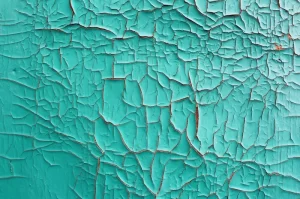
So, what happens when the backing expands and contracts due to the heat and/or moisture of a wet climate? Simple. The paint starts to flake off or crack. The varnish cracks. Even micro-cracks are bad. The photo paper warps and the finish cracks. In short, the destruction of the image begins. You cannot stop it once it starts. You can only delay it. But you cannot fix the damage.
The picture frames and support frames of your favorite fine art are susceptible to all of these problems. Also, there’s another problem which you might not have considered with them. The frames and framing might desiccate or over-saturate to the point of doing damage to both themselves and the art.
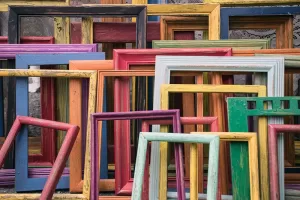
Desiccation will lead to the wood frame/framing drying out and shrinking. With dried out wood, it will pull moisture out of the art to try and maintain some form of equilibrium. Dried out fine art becomes brittle. With the shrinking side, the framing will no longer hold the canvas taut. The wood could even split. The canvas will warp and perhaps bubble. In worst cases, the framing will tear up or through the canvas. Desiccated picture frames will open up holes which some of those insects listed above might like to nest in. Also, it won’t protect completely against water or other contaminations anymore. It will loosen at the joints or nails/tacks. The wooden frame might fall apart.

Conversely, over-saturated wood will leech into the art. Who knows what that water will bring with it? Will it permanently stain? Watercolors (and other water-soluble inks or paints) are particularly vulnerable to this problem. You could lose the entire image. While much less likely, extremely over-saturated wood will swell. This might cause nails, tacks, and even joints to tear. In worst case scenarios, they might pop open due to the stress. We don’t want exploding fine art.
Now that we understand some of the dangers which fine wall art faces in wet climates, what can we do about it? How do we properly care for fine art in wet climates? How do we keep it lasting as long as possible? The simplest answer is to climate control. Here are a few ways.
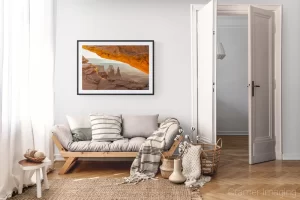
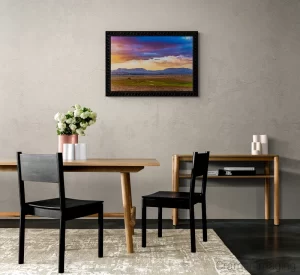
Experts say that you want to keep your art in somewhere between 65° and 75° Fahrenheit and between 40-60% humidity. While I realize that some places on the planet make that more difficult than others, it’s something to strive for. If climate control isn’t an option for you for reasons, then do your best. In such situations, the above advice, especially the inspection advice, is even more important.
In conclusion, properly caring for your fine art in wet climates is mostly about preparation and staging. If you climate control and keep the place clean, then you can avoid many of the problems associated with wet climates and fine art. Then you need not worry about the longevity of your wall art. It will probably last as long as it possible can. While nothing can last forever, you will certainly maximize the life of your treasured fine art.


Receive monthly updates in your inbox from us.

Join our email-only photo of the week club to get the full stories behind how we captured our favorite fine art landscape photos.
We respect your privacy
No More Results